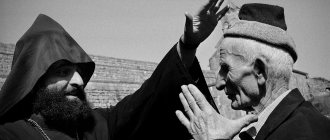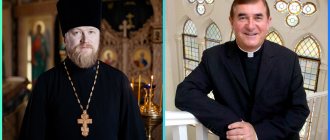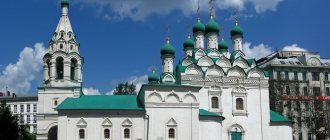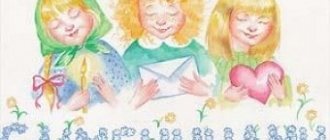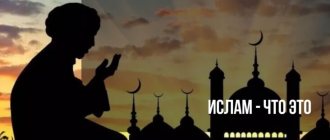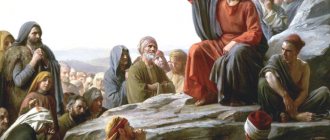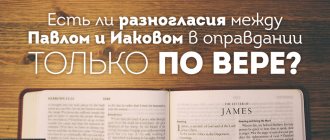Yulia Serebryakova – Fundamentals of Orthodoxy
E. N. Nikulina, Yulia Serebryakova, Nikolai Serebryakov
Fundamentals of Orthodoxy
Reviewer:
Ph.D. theology, associate professor P. Yu. Malkov
© Serebryakova Yu. V., Nikulina E. N., Serebryakov N. S., 2010
© Design. Publishing house of the Orthodox St. Tikhon's Humanitarian University, 2013
* * *
Preface
This textbook is aimed primarily at future students of the Faculty of Further Education (FED) of PSTGU, therefore it is compiled in accordance with the program of entrance interviews on the basics of Christianity (Orthodoxy) adopted at the faculty.
The sequence of the seven sections of the manual reflects the recommended order of studying the foundations of Orthodoxy: first, the sacred history of the Old and New Testaments[1], then a systematic presentation of the foundations of Christian doctrine (in the volume of the Creed), a description of the liturgical life of the Church (the meaning of the Sacraments, the meaning of the twelve feasts, the order of the celebration of church services), and, finally, an overview of church history (the main stages of the history of the Universal Church and the Russian Orthodox Church), which is a continuation of the sacred history of the New Testament. Consistent reading will also allow you to gradually master basic theological vocabulary.
Why does the study of the foundations of Orthodoxy begin with an acquaintance with the history of the Old Testament? Christians believe that God is God the Trinity: Father, Son and Holy Spirit, and that the Second Person of the Holy Trinity, God the Son, became man for the salvation of people and delivered people from the power of death, sin and the devil. But how people fell under the power of death, sin and the devil, about why humanity needed the coming of the Savior, about the history of the expectation of the Messiah is told in the Scriptures of the Old Testament - and without this context it is impossible to understand the New Testament history.
The Scriptures of the New Testament speak about the event of the Incarnation, about the Lord Jesus Christ preaching repentance and the approach of the Kingdom of God, about His death on the Cross and Resurrection, about the formation of the Holy Church by the Son of God through the sending of the Holy Spirit and the beginning of the spread of Christianity by the apostles, disciples of Christ. The second section of the manual is devoted to a commentary review of these events.
The next three sections of the manual contain a brief summary of the dogmatic teaching of the Orthodox Church and an overview of its liturgical life. The Holy Church is the guardian of Divine Revelation and true worship of God. Through the Church, people assimilate the fruits of redemption and salvation accomplished by the God-man Jesus Christ. It restores the connection between man and God, broken at the time of the fall of our ancestors, and human nature damaged by sin. This restoration is served by the Church Sacraments established by God. Through the Sacrament of Baptism, a person enters the Church, and through participation in the Sacrament of the Eucharist, he lives in Her. All aspects of human life receive sanctification in the Church through the Holy Sacraments. In addition to the Sacraments, the Church has liturgical life - an external expression of a person’s inner aspiration towards the Creator. If the Sacraments are what God gave to man, then worship and prayer are man’s grateful response.
Staying in the Church is possible only under the condition of faithfulness to the teachings of Christ, transmitted to us through the holy apostles. But not all Christians have preserved the purity of Divine Revelation and true worship of God. There are known cases of mass apostasy from the Church, the largest of which is the apostasy of the Roman Church (11th century). In the 16th century, Protestantism separated from it, which subsequently split into numerous movements. But the Universal Church continues to preserve intact the teaching of the Lord Jesus Christ and the apostolic succession. It is called Orthodox because it correctly glorifies God, that is, it preserves true worship of God. The sixth section of the manual is devoted to a review of key events in the history of the universal Church.
The manual ends with a brief history of the Russian Orthodox Church: from baptism and the beginning of the Christianization of our country to the persecution of the Church in the twentieth century and the glorification of the feat of the new martyrs and confessors of Russia.
The authors express their heartfelt gratitude to the head of the department of theology of PSTGU P. Yu. Malkov for valuable advice on the content of the manual, as well as to their colleagues - teachers of PSTGU Abbot Tikhon (Polyansky) and N. D. Gimranov for their help in selecting materials for the sections “The Sacred History of the Old Testament ”, “Orthodox doctrine”, “Main events in the history of the Universal Church”, “Main events in the history of the Russian Orthodox Church”.
Section 1. Sacred History of the Old Testament
The meaning of the concepts “Divine Revelation”, “Holy Tradition”, “Holy Scripture”, “Bible”, “Old and New Testaments”
The purpose of Divine economy, that is, God's care for His creation, is the salvation of man and his union with the Creator. Evidence of God's care for humanity is Divine Revelation - what “God Himself wished to reveal to people so that they could correctly and savingly believe in Him and honor Him worthily”[2].
Divine Revelation is preserved in the Church and spread among people through Sacred Tradition. “Under the name of Sacred Tradition we mean when true believers and those who revere God by word and example pass on to one another, and ancestors to descendants, the teachings of faith, the law of God, the Sacraments and sacred rites” [3]. The word “tradition” itself (Greek paradosis) means transmission, leaving as an inheritance. It indicates, first of all, the action, that is, the process of transmission itself: “... I received from the Lord Himself what I also passed on to you,” says St. ap. Paul (1 Cor. 11.23).
One of the forms of Sacred Tradition is the Holy Scripture, or the Bible. The Bible is a Greek word, translated into Russian by the word “books”. It is a collection of books, most of which are inspired, that is, written by people chosen by God (prophets and apostles) under the inspiration of the Holy Spirit. The Bible is called Holy Scripture because everything that comes from God is holy.
The Bible is divided into two sections - the Old Testament and the New Testament. "Covenant" means the union of God with people. The Old Testament was concluded immediately after the fall of the first people and continued until the coming into the world of Christ the Savior - the Son of God. With the coming of the Savior, a New Covenant was established between God and people, which, unlike the Old, is an eternal covenant.
The Bible consists of 77 books: 50 Old Testament and 27 New Testament. The Old Testament books are divided into canonical (39 books) and non-canonical (11 books). Canonical books, according to the teaching of the Church, are inspired by God; non-canonical ones are not recognized as inspired, but, due to their edifying nature, are recommended for Christians to read.
All the canonical books of the Old Testament were originally written in Hebrew. In the 3rd century BC. e. The Old Testament books were translated into Greek. According to legend, this work was done by 72 interpreters, so their translation is called the translation of the seventy-two or simply the translation of the seventy (abbreviated as LXX) or the Septuagint.
The books of the New Testament were written in ancient Greek, with the exception of the Gospel of Matthew, whose original language was most likely Hebrew.
Starting from the 4th century after R.H. The translation of the entire Bible - both the Old and the New Testament - into other languages began. The Bible was translated into Slavic in the second half of the 9th century through the works of the holy brothers, Equal-to-the-Apostles Cyril and Methodius. The Bible was translated into Russian in the 19th century. This translation was made with the blessing of the Holy Synod, which is why it is called the Synodal translation.
According to their content, the books of the Old Testament are conventionally divided into four categories: law-giving, historical, teaching and prophetic. But with all the diversity of content, a single idea runs through all the books of the Bible - the education and salvation of fallen man.
The origin of the world and the fall of our ancestors
The biblical account of the creation of the world and man. Life of the first people in paradise. The fall of the first parents and its consequences, the concept of original sin, the promise of the Savior (Gen. 3.15).
You may wonder why, having assumed to talk about the incarnation of the Word, we now talk about the beginning of people. But this is not alien to the purpose of our reasoning. Speaking about the coming of the Savior to us, it is necessary for us to talk about the beginning of people. From this you will learn that our guilt was the reason for His coming, and our crime caused the love of the Word, so that the Lord would come to us and appear among people.
St. Athanasius of Alexandria.
About the incarnation of God the Word, and about His coming to us in the flesh, 1:4[4]
Disagreements
Even at first glance, significant differences between Catholics and Orthodox can be observed in many things:
- priests' clothing;
- order of cults;
- view of the church;
- method of melting the Cross;
- accompanying sound of liturgies.
- Orthodox priests do not shave their beards.
What differentiates Orthodoxy from Christianity from other religions is the Eastern style of worship. The Orthodox Church has preserved the Eastern tradition of sensuality, there are no musical instruments in cults, it is customary to light candles and burn incense, and make the sign of the cross with your fingers from right to left and make a hand.
Orthodox Christians believe that their church has its origins in the crucifixion and Resurrection of the Savior. The Baptism of Rus' took place in 988, a Byzantine tradition that continues to this day.
Comparison of Christians and Orthodox
Orthodoxy has proven faith, with its dogmas, its values, its thousand-year history. According to Christianity, it is often given that there is, in fact, no such thing. For example, the White Brotherhood movement, active in Kyiv in the early 90s of the last century. For Orthodox Christians, their main thinking is fulfilling the commandments of the Gospel, their own salvation and the salvation of their spiritual neighbor from the enslavement of passions. The legacy of Christianity at its congresses announces salvation in a purely material sense - from poverty - disease, war, drugs, etc., which is external piety.
For the Orthodox, the spiritual meaning of human holiness. The proof of this is the saints, the Orthodox Church, the life of the Christian ideal. In Christianity, in general, the mind and feelings are higher than the spiritual. Orthodox Christians consider themselves to be God's companions in the work of their salvation. In Christianity, especially in Protestantism, a person is like a column that does not have to do anything, because for him he performed a saving work on Calvary of Christ.
The basis of the doctrine of the world faith of Christianity is the Holy Scripture - the Scripture of Divine Revelation. She teaches us how to live. Orthodox Christians, like Catholics, believe that Scripture is distinguished from a sacred tradition that explains a way of life and is also an undisputed authority. Protestant churches of the movement rejected this claim.
A summary of the fundamentals of the Christian faith is given in the Creed. For the Orthodox, this is a symbol of the Nicene-Constantinopolitan faith. Catholics have in the text a symbol of the concept of the son, according to which the Holy Spirit is from God the Father and God the Son. Protestants do not reject the Nicene Creed, but what they have accepted is considered the ancient Apostolic Creed.
Orthodox Christians especially honor the Mother of God. They believe that he had no personal sin, but he was not without original sin, like all people. After the Ascension of the Mother of God, he ascended to heaven. However, there is no dogma. Catholics believe that the Mother of God lacks original sin. One of the dogmas of the Catholic faith is the dogma of the bodily Assumption into heaven of the Virgin Mary. Protestants and numerous sectarians do not worship the Mother of God.
Orthodox Christianity is embodied in church dogmas. Not all movements that call themselves Christians are actually Christians. For Orthodox Christians, inner piety is the basis of a righteous life. For modern Christianity in its masses, external piety is much more important.
Orthodox Christians strive for spiritual holiness. Christianity in general, focusing on spirituality and sensuality. This is clearly seen in the example of Orthodox and other Christian preachers.
The Orthodox is an ally of God in his own salvation. Catholics also take the same position. Other representatives of the Christian world are convinced that salvation is not a moral achievement of man. Salvation was accomplished at Calvary. The basis of a person's faith is the Holy Scripture and sacred tradition, as for Catholics. Protestants rejected tradition. Many Christian sectarians of the movement also distort writing.
A summary of the fundamentals of the Orthodox faith is given in the Nicaea Creed. Catholics added the concept of filioque to the symbol. Most Protestants accept the ancient creed of the Apostles. Many others have no sense of faith. Only Orthodox and Catholics venerate the Mother of God. There are no other Christians of his cult.
Christian Catholicism differs from Orthodox Christianity in its approaches to the celebration of worship and worship. In the Roman Catholic Church tradition, the head of the church is the Pope, and not Jesus Christ, as in Orthodoxy.
Catholic differences from the Christian faith, from the Christian Orthodox Church:
Autocephaly what is in the church in simple language
The Holy Spirit also comes from the Son of God, to the same extent as from the Father; he was born of an immaculate virgin and was accepted into heaven in body and not only in soul; * Catholics venerate a large number of different Saints; * the pope, as the Supreme Hierarch of the church, considers all actions infallible; * after the death of the body, the soul is not killed, unlike Orthodox Christianity, but it turns out that they are in purgatory, where trials await them; For communion you need bread without yeast.
The fundamental difference between Catholic Christianity and Orthodoxy is the concept of atonement for sins with gifts (indulgences). Western tradition believes that Christ, the Mother of God and the saints through their actions created an inexhaustible supply of kindness, which is enough to cover all the sins of the entire Christian community. The Sanctuary of Goodness is owned by the Christian Catholic Church and is sold to sinners in the form of special ratifications, meaning homeowners receive absolution.
